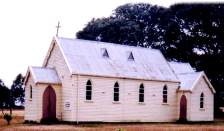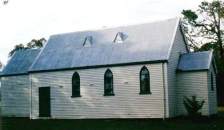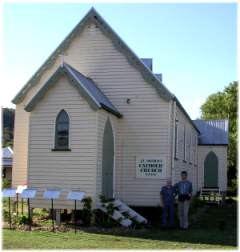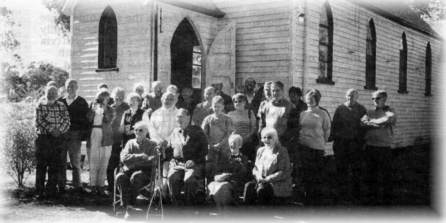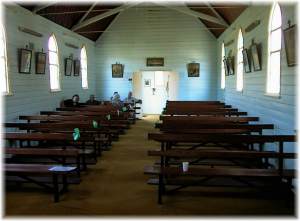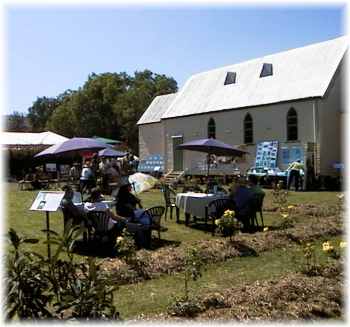|

Kevin also tends a remarkable
collection of old Holdens.
From the Benalla
Ensign, 2003: By Vincent Branigan
“I was baptised in this church the day it was opened!”
It was a proud boast uttered many times by my paternal grandfather while I grew
up in the 1960s and early 1970s.
Every second Sunday, we dutifully gave one hour back to our maker at St
Patrick’s, Rothesay... that old weatherboard church that has now stood
innocuously behind those massive pine trees at the intersection of the Samaria
and Tatong Roads for over 103 years.
On May 3, Father Dennis Crameri celebrated Mass at St Patrick’s, Rothesay for
the final time.
The congregation was made up of familiar faces from my childhood, such as Jack
Duffy and Margaret McCauley and people like Denise O’Brien making a sentimental
journey back to their roots.
Finally, there was a sprinkling of parishioners from Benalla simply with a
profound sense of history.
During and after the service it was a time for much reminiscing and nostalgia.
But what an important occasion it must have been on Sunday, February 10, 1900
for my great grandparents, their three young children and the Tatong, Samaria
and Swanpool communities.
The church already had had another life, having been moved by horse and cart
from Violet Town (over 50 kms away) to its current site.
It must not have been easy for my great grandmother.
Having given birth to her third child, Percival Sebastian (my grandfather) three
weeks earlier on the family farm at Swanpool, she would have been anxious, no
doubt, to ensure that her eldest child, nine-year-old Mary (who in 1923 was to
bleed to death giving birth to her first child), was in her Sunday best.
Her second child, five-year-old Christopher (who in 1917 was rendered a
paraplegic in the madness that was the trenches of World War I) would probably
have been a handful.
Then there was the 10 km journey by horse and cart along the dirt tracks on what
was most likely a stifling hot summer’s day.
Three days later, on February 13, 1900, the Benalla Standard reported on the
opening of St Patrick’s, Rothesay:
‘The opening on Sunday was taken in hand by His Lordship, the Coadjutor Bishop
of Bendigo, Dr Revile, assisted by The Very Reverend Dean Davey who performed
the dedication ceremony.
“It was attended by a large crowd of many persons of different denominations or
gratifications expressed on all sides.
“There were three children christened at the church on Sunday. They were: George
Ginnivan, son of Mr and Mrs John Ginnivan of Samaria; Mamie Sullivan, daughter
of Mr and Mrs Thomas Sullivan of Tatong and Percy Branigan, son of Mr and Mrs
Matthew Branigan of Swanpool.”
The building has been purchased by a parishioner and will soon be relocated a
second time to a site near Tatong.
According to Father Dennis, it will still be available for the odd service and
special occasion such as a wedding or funeral.
The land will eventually be sold.
- Vincent Branigan

|
A Potted History of
St Patrick
(Potted from several difference
sources)
Saint Patrick is believed to have been born Patricius Magonus Sucatus, or Succat,
in the late 4th century, possibly 385 or 389.
According to his "Confession" he was born in the little settlement of Bannavem
of Taburnia (vico banavem taburniae) which may have been in Britain, Wales, or
perhaps in northern France. His father was a Roman official.
By his own account, at age 16 he was captured by seafaring raiders who sold him
into slavery in Ireland where he spent six years.
On escaping he studied for the priesthood in France and eventually made his way
back to Ireland, to continue the work of the Christian missionary Palladius.
Ireland fully converted to Christianity within 200 years and was the only
country in Europe to Christianize peacefully. Patrick's Christian conversion
ended slavery, human sacrifice, and most intertribal warfare in Ireland.
He is thought to have died on March 17 in the year 460, 461, 492, or 493, at Saul, Downpatrick, Ireland, or at Glastonbury, England.
Most of what is known about him comes from his two works, the Confessio, a
spiritual autobiography, and his Epistola, a denunciation of British
mistreatment of Irish Christians.
Saint Patrick is credited with driving snakes from Ireland, but it is unlikely
there ever were any. The idea was probably symbolic of the ending of pagan
practices.
Legend tells that Patrick taught the Irish about the Trinity by using the
shamrock, a three-leaved clover; but that legend appears to have begun in the 18th-century.
While not the first to bring Christianity to Ireland, Patrick is said to have
encountered the Druids at Tara and abolished their pagan rites.
Ireland's Catholics and Protestants each have built St. Patrick in their own
image. Catholics say that Patrick was consecrated as a bishop and that the pope
himself sent him to convert the heathen Irish.
Ireland's Protestant minority deny this, depicting him as anti-Roman-Catholic
and crediting him with inventing a distinctly Celtic church
St. Patrick is also patron of Nigeria, which was evangelized primarily by Irish
clergy. |
